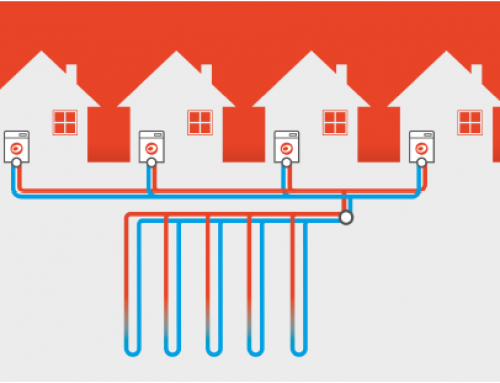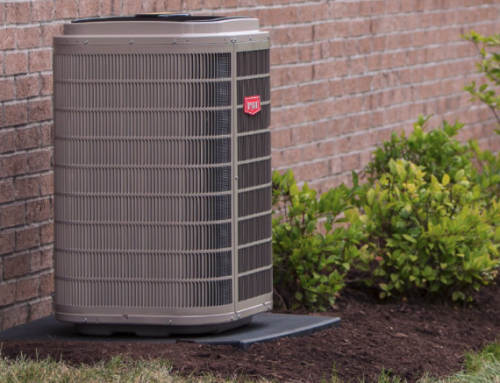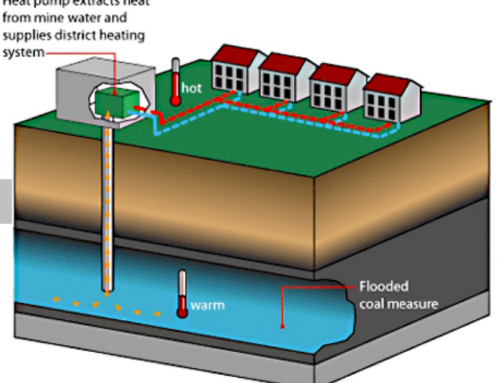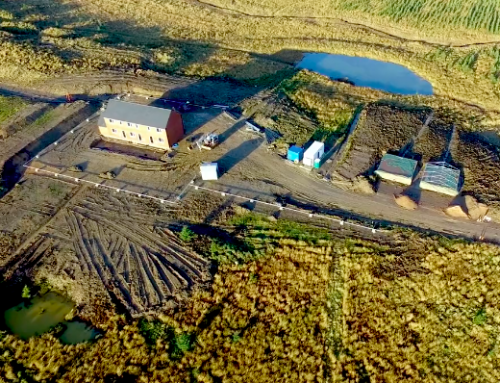The previous article on Decarbonising Heat summed up the National Infrastructure Commission’s study of the cost of different solutions to this problem. The most effective, but also the most expensive, was found to be the heat pump. This article will look into the pros and cons of heat pumps, and also into a solution that combines heat pumps with traditional gas heating.
A heat pump takes heat from the air or the ground (or sometimes from running water) and uses electricity to boost it to heat the home and provide hot water. A typical air-source pump can provide around three or four times as much heat energy as the electrical energy it consumes. A ground-source pump can provide more but is not practical for the majority of UK homes as it requires a significant land area.
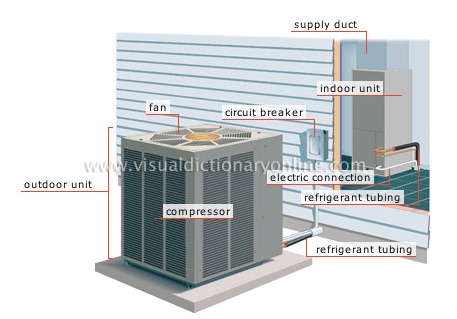
An air-source heat pump (www.visualdictionaryonline.com)
The gain in useful energy is very attractive, but there are disadvantages. Heat pumps are good at supplying lots of low-temperature heat at about 300C, but become less efficient at higher temperatures. This is a problem because people like hot water at 450or higher, and to be effective radiators need water above 500. Ideally the latter should be replaced by underfloor or wall heating, but this is impractical in most existing homes. Instead large heating panels are required. The home must also be well insulated.
Heat pumps have some other drawbacks. They are physically larger than gas boilers, so may not be easy to install. They also require a fixture on an external wall and a hot water tank, something that no longer exists in homes with combination boilers.
The study commissioned by the NIC assumes that heat pumps will only be used in homes with high thermal-efficiency. It considers different scenarios for upgrading existing buildings, as discussed in the previous article. It then calculates the additional cost of converting to heat pumps compared with the Status Quo, in which gas boilers continue to be used but electricity is decarbonised and new buildings slowly replace older, less thermally-efficient ones. It takes into account the higher cost of a heat pump including heating panels and other accessories, the cost of efficiency upgrades in each scenario, and the cost of using electricity rather than gas.
(The study assumes a suitable mixture of air-source and ground-source heat pumps producing 2.7 kWh of heat for 1 kWh of electricity, but since electricity is estimated to cost more than gas by a factor of 3.2 today, dropping to 2.4 after 2035, there is little overall change in the cost of fuel.)
There is another extra cost, related to electricity transmission and distribution. While the average heat energy needed over the year is similar to electricity it is of course all concentrated in the winter months where it can reach three times the yearly average. To handle this surge in power, electricity grids will need to be upgraded significantly.
The resultant cumulative costs to 2050 are shown for each of the efficiency upgrade scenarios in the plot below, as are the CO2 emissions in 2050. In the highest efficiency case emissions are reduced to an acceptable 7MtCO2/year for an additional discounted cost of £264bn. The annual heating cost per home in 2050 rises from £840 per year for the Status Quo to £1070. There are big uncertainties in these numbers, with the largest related to the cost and performance of the heat pump.
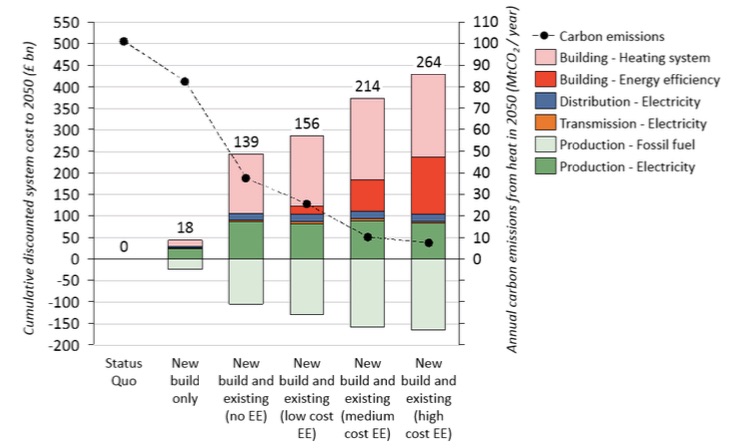
The vertical bars show the cost to 2050 above the Status Quo for six different cases of Energy Efficiency measures. The numbers above the bars show the net cost after taking into account the saving in gas. The black dots show the emissions for each case with the scale on the right. (from Cost Analysis of Future Heat Infrastructure Options by elementenergy and E4tech)
The high cost and uncertainty have motivated the search for a hybrid solution, in which the heat pump provides the heat needed for most of the year but gas is used for the peak winter months and for peak hot water. The heat pump can then be smaller and there is no need to replace radiators with heating panels or to make homes highly energy efficient.
As might be expected, costs are less but CO2 emissions are higher. For the high efficiency case the cost drops from £264bn to £179bn in the hybrid solution, but the CO2 emissions in 2050 rise from 7 to 24 MtCO2/year, well above the goal of 10 MtCO2/year. The annual heating costs per home are nearly the same. There are additional uncertainties in the hybrid systems, not the least being how people use them – will they use more gas than they should because of its fast response and high temperature?
One way to reduce effective gas emissions would be to use biomethane from landfills, waste and sustainable biomass. However there is great uncertainty as to how much will be available in 2050, and what percentage will be used for heating rather than by industry, transport and power plants. Several scenarios were analysed in which biomethane provides between 2 and 12 per cent of total heat. In the medium scenario, emissions drop to 18MtCO2/year, worse than the heat-pump-only case, while costs are about the same at £216bn.
In summary, heat pumps can reduce emissions to acceptable levels but are expensive and disruptive. Can we do better by replacing natural gas with hydrogen? This will be discussed in a subsequent article.
Reference: National Infrastructure Assessment July 2018


